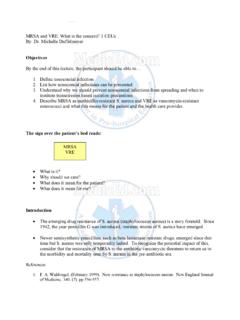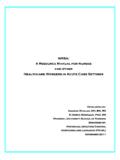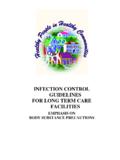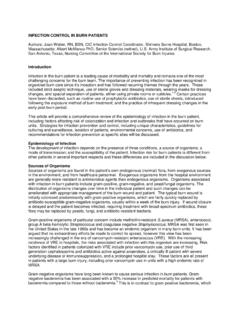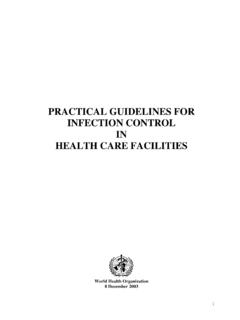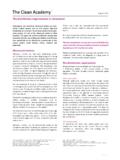Transcription of Beta-lactam antibiotics - Cephalosporins
1 1 Beta-lactam antibiotics - CephalosporinsTargets - PBP sActivity -Cidal- growing organisms (like the penicillins)Principles of action - Affinity for PBP sPermeability propertiesStability to bacterial enzymes2 CephalosporinsDevelopment - Giuseppe Brodtzu - Sardinian sewageCephalosporin C - CephalothinNo meningeal penetrationFailed in meningococcal meningitisPainful to give IMAdvantagesCephalosporin nucleus - resistant to Staphylococcal penicillinaseCephalosporin nucleus - more readily modifiedDevelopment of C sporinsGenerations- in response to clinical needsFirst generation- Cephalothin (not used)Cefazolinoral - Cephalexin, cefaclorActivity - Broad spectrum:Gram positive Streptococci, S. aureusGram negative , KlebsiellaNo activity against Enterococci- different PBP s3 Second generation C sporinsCefuroximeCefoxitinCefotetan70 s - Beta-lactamase s recognized (H. influenzae)Anaerobic infections Cefoxitin - Methoxy group - conferred beta-lactamase stabilityInduction of chromosomal beta-lactamasesBacteroides fragilis- enteric anaerobesCefuroxime - Respiratory tract infections -community acquired4 Kinetics of c sporin bindingAffinity for receptor - PBPP ermeability characteristics of the porinBeta-lactamase production - within periplasmic space5 Third generation C sporins80 s - Intensive care - nosocomial infectionsMulti-Resistant Gram negative organismsChromosomal beta-lactamase - C sporinaseInduciblePlasmid mediated enzymes - mutants withboth Penicillinase and C sporinase activityPermeability limitationsThird generation c sporinsCefotaximeCeftriaxoneCeftazidimeC efipime (4th?)
2 Highly active - Cefotaxime -S. pneumoN. meningitidis, gets across BBBC eftriaxone- even more active - Single dose IMget meningeal levels - Long half life !!!N. gonorrhoeae, use in unreliable patients -Cover S. pneumoniabacteremiaUse in meningitis -67 Ceftazidime/Cefepime - anti-PseudomonasUsed the side groups which have increased permeability -? Induction (low level) of chromosomal C sporinaseBeta-lactamase stable -less activity against gram positive organisms8 Cefepime Fourth generationIncreased beta-lactamase stabilityAlso better Gram positive -CarbapenemsImipenemMeropenemErtapenemBe ta- lactam class - PBP-2 major targetPermeability - separate porinHuge spectrum- Aerobes, anaerobeseverything - CNS side effects - Imipenem ??9 Monobactams - AztreonamOnly binds to Gram negative PBP sNo real Beta-lactam ring - therefore beta-lactamase stableNarrow spectrum - Only aerobic gram negative rodsUse - instead of an aminoglycoside10 Use of the Cephalosporins :Increased - due to resistantS.
3 Pneumoniae -susceptible to cefotaxime and ceftriaxoneGram negative infections - hospital acquired - selection ofresistant organismsFirst generation- Oral - surgical prophylaxis - skin soft tissueinfections - taste good - house cephalosprorin Second generation- Some oral - some parenteralSelected uses community acquired infectionsParenteral -Third generation11 Resistance RatesMYSTIC program (USA 199-2006)>100 medical centersResistance to carbapenemsEnterobacteriaciae (9,396 organisms) aeruginosa(3,100 organisms) All (20,051) PharmacologyCharged - hydrophilic - do not enter phagocytic cellsVariably protein bound (Ceftriaxone - highly bound)Variable half-livesMetabolism - Cefotaxime - Liver - desacetyl derivative - activeExcretion - Renal - Tubular secretion and glomerular filtration12 Beta-lactams side effectspenicillin c sporin cross reactivity 3-7%(depending on the drug)Hypersensitivity RashIgE-mediated allergy Anaphylaxis Major determinants minor side effectsMinor determinants MAJOR reactionsDiarrheaNeutropeniaCNS high doses -especially the carbapenemsC sporinsIntrinsic resistance - enterococci - different targetsAcquired resistance - active change Acquisition of an enzymeInduction of an enzymeSelection of a mutation Alteration in permeability13 VancomycinHistory - Developed in the 50 s - anti-Staph drugRe- discovered - MRSA - and MRSE -Staphylococciwith altered PBP-2 AmecAgene - no longer binds penicillin(C sporins don t bind either)
4 Target -D-ala-D-ala- pentapeptideblocks two steps in cell wall synthesisCidal - Only gram positives - Highly resistantS. pneumo1415 Use of VancomycinStaphylococci resistant to penicillin methicillin resistant - Altered PBP sCoagulase-negative staphylococci Catheter infectionS. aureus MRSA Methicillin Resistant Staphylococcusaureus01020304050607019951 99619971998199920002001200220032004 YearPercent ResistanceMethicillin (oxacillin)-resistant Staphylococcus aureus(MRSA) Among ICU Patients, 1995-200416 MRSA - typesNosocomial Multi-resistant large chromosomal insertions mecAcassette Community SCC s (small covalent circles)Integrated elements along with the recombinasesVery common moving back into the hospitalCommunity Acquired MRSAI ncreasingly common smaller mobile genetic unitStill susceptible to other antibiotics (unlike hospital acquired)Often relatively virulent Panton-Valentine toxinSkin- soft tissue infectionsFulminant pneumoniasAdolescentsUp to 70% of outpatient isolates !
5 !!! At some centers17 Small glycoprotein (MWt@ 1,450) derived from Nocardia orientalisActivity - most G(+) bacteria including Streptococci, Corynebacteria, Clostridia, Listeria, and Bacillus species. Bactericidal at levels - 3 mg/LStaphylococci including -lactamase producing and methicillin resistant species are killed at levels <10 mg/L Vancomycin - propertiesVd @ L/kgProtein binding @ 55%Elimination: > 90% renalHalf-life @ 7 hrs (with normal CLcr)Vancomycin is not removed by standard HD or PD, but it is removed by CVVHV ancomycin - Pharamacokinetic properties18 Side effects of vancomycin:Red man syndrome - histamine-mediated erythematous flushingof the face, neck and trunk, a reaction which occurs during theinfusion, and may be associated with and ototoxicity ?? < 1% of pts especially those receiving other "toxic' drugslike aminoglycosides. A relationship between vancomycin level and nephrotoxicityor ototoxicity has not been established.
6 It is now widely believed that the earlierreports of nephrotoxicity may have been related toimpurities in the product. Vancomycin resistanceVRE = Vancomycin resistant enterococci? From oral use of vancomycinSelection of enterococci altered cell wall structureSeveral mechanisms:D-ala-D-ala changed to a lactateNo metabolic costSeveral Vanco resistance cassettes1905101520253035199519961997199 8199920002001200220032004 YearPercent ResistanceVancomycin-resistant EnterocociAmong ICU Patients,1995-2004 Source: National Nosocomial Infections Surveillance (NNIS) System20 Vanco resistant S. aureus VISA Vanco intermediate MIC s 4-16 micrograms/mlMultiple point mutationsThickened peptidoglycan layer ? Sponge effect(GISA = glycopeptide-intermediate strains)










